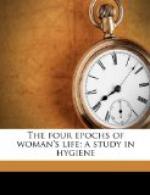We have seen that, in accordance with the plethric theory, which prevailed until 1835, and with the nerve theory, which is based on the latest anatomic and physiologic researches, menstruation is a physiologic process to get rid of effete material, and is therefore an excretion.
At the end of perhaps thirty years, by a conservative process of nature, the child-bearing period ceases and the organism is readjusted to the end that the woman’s vitality may all be conserved for her own individual life.
Each metamorphic or developmental period of life— dentition, puberty, and the menopause— throws a special strain on the nervous system, and the recent studies of the sympathetic nervous system at the time of the menopause show that very extensive anatomic changes occur at this time. That being the case, the woman must lead such a life as will insure her having on hand a large reserve force necessary to meet these heavy demands. Tilt’s observations show that women who have experienced no suffering at puberty or, at the menstrual periods do not suffer at the menopause. It is therefore evident that the time to begin this preparation is in childhood.
That single women suffer less than married women would suggest that excessive coitus and the occurrence of abortions, frequent child-bearing, and lesions as the result of pregnancies, many of which lesions could have been prevented or cured by the timely aid of the physician, are the combined sources of much of the suffering at the time of the menopause.
That the most frequent and serious disturbances are those of the nervous system, and that from their mode of life and habits of introspection the rich suffer more from these ailments than the poor, must cause serious consideration of the physiologic necessity for a definite occupation for the daughters as well as for the sons of the rich.
The frequency with which Bright’s disease is found at the time of the menopause is dependent not so much on the local physiologic changes which are taking place as on the time of life. Loomis says that it was not until life-insurance examinations became so common that the frequency with which kidney disease existed in persons who believed themselves well was even imagined. And as a result of his observations in these cases, and of a large number of autopsies conducted at the Bellevue, he stated that it was his belief that 90% of men and women over forty years of age suffer from some form of Bright’s disease. That being the case, it would seem that after this period of life at least as much attention should be directed to the kidneys as to the teeth, and that a semi-annual examination of the urine should be made.
Although the menopause is a physiologic occurrence, yet, owing to the many pathologic changes which are liable to take place at this time, the woman should be as carefully watched during the menopause by the gynecologist as the pregnant woman now is by the obstetrician. If the same care were taken, in the majority of cases, the dangers attending the menopause would be avoided, and the woman would be prepared to enjoy a healthy and useful post-climacteric period of life.




